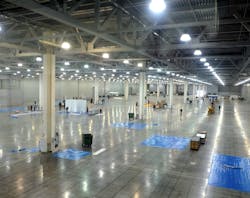Use HTHV Technology for Destratification in Winter
Too often, however, older HVAC systems struggle to evenly distribute warmth where it is needed. As they work overtime to keep up with cold outdoor temperatures seeping in through open doors, rising heat escapes through the roof in a process known as stratification.
Industrial facilities and high-bay distribution centers are particularly at risk for the lost energy and discomfort of stratification. When heating a high-bay facility, it is critical to use one or more destratification technologies.
Destratification Options for High-Bay Buildings
Recirculation with large blowers or destratification fans are one way to accomplish this. High-temperature heating and ventilation technology, or HTHV, is another solution, particularly for building managers looking to maximize operations budgets and equipment space.
HTHV systems draw in air completely from the outside, heat it to a maximum of 160 degrees F., and then discharge it via high-velocity blowers built into the unit.
[Related: Why You Should Specify Advanced Rooftop Units]
The use of 100 percent outdoor air makes HTHV a viable choice for ventilation, and the built-in blowers are strong enough to address stratification issues. This reduces the need for the significant horsepower of recirculation systems or additional equipment, such as high-volume, low speed fans, ultimately lowering installation costs associated with unit counts, gas piping, electrical runs and labor.
In fact, the lack of additional destratification equipment was what drew Cruiser RV to HTHV technology when it came time for the maker of travel trailers to upgrade its HVAC system in advance of a cold northern Indiana winter.
Temperature Study Leads Cruiser RV to Destratification Solution
For a family-owned company priding itself on work ethic and skilled craftsmanship, employee comfort was essential to Cruiser RV. It needed a heating solution that could deliver comfort 24 hours-a-day, 7 days-a-week, over 200,000 square-feet of space.
Many HVAC systems can be customized to meet unique building needs, and temperature studies can often help facility managers identify the best solution to a stratification challenge. Cruiser RV’s challenge was its 28-foot ceilings and 34 active doors.
While HTHV’s high-velocity blowers meant Cruiser RV could save on initial equipment and installation costs, a temperature audit helped the facility manager understand the temperature variances and make the right decision for the building’s needs.
[Read also: New Evaporative Cooling Solution for Data Centers]
Working with engineering specialists to measure the temperature variances taking place inside, the Cruiser RV team placed data loggers in three places 5 feet off the ground and three places 2 feet from the ceiling.
While outside temperatures ranged radically from a balmy high of 59 degrees F. in mid-January to a frosty -15 in early February, the HTHV unit pumped clean, heated outdoor air throughout the facility. Temperatures collected every 30 minutes over the eight weeks remained within a comfortable and constant 2- to 3-degree range of the desired temperature.
The proven minimal temperature variance and lower installation costs made HTHV a fit for Cruiser RV, but other types of site studies have helped facility managers identify ways to boost HVAC energy efficiency and ultimately lower the cost of winter heating bills.
Site Study Leads Food Distributor to Efficient Retrofit
A Giant Eagle distributor was one business that conducted a survey to analyze energy use when it came time to replace an aging HVAC system inside its 61-dock-door distribution center in Cleveland. Comfort, energy efficiency and ROI were key factors for the grocer, which learned of HTHV through a contractor.
A 2014 U.S. Department of Energy field study found that HTHV can reduce overall natural gas consumption by at least 20 percent over traditional unit heaters. The reason is inherent to HTHV’s design: HTHV uses a 92 percent efficient direct fired technology that evenly warms facilities.
While building variables can impact efficiency, building studies conducted by Cambridge Engineering for customers have seen HTHV achieve 70 percent better energy efficiency that other indirect and direct-fired heating models. Site surveys can help facility managers maximize savings more effectively.
The distributor’s site survey collected information required to calculate heat load as well as the ROI of replacing its old unit heaters with HTHV technology. By installing six HTHV units, the grocer found it could keep its 540,700-square-foot facility warm and realize a 30 percent savings on utility bills.
Furthering the ROI gains, Giant Eagle’s HTHV installation also qualified for commercial rebates through its natural gas provider. While many utilities have offered custom HTHV rebates for more than a decade, some are also now beginning to add prescriptive rebates.
If ROI is a key factor in your HVAC system, these are worth exploring, as amounts vary and can often offset up to 50 percent of the cost.
Comfort is the Bottom Line
Whether it’s a production facility or a high-bay distribution center, HTHV heating technology provides an efficient solution for combatting stratification issues that strike in the winter. If your facility suffered from inconsistent temperatures, rising utility bills or changing pressurization last winter, it may be time for a retrofit.
Two handpicked articles to read next:
